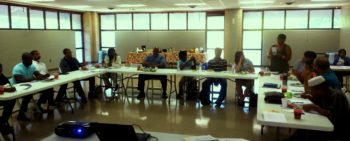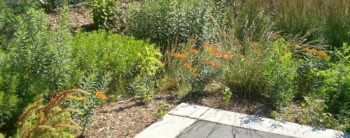Building a Voice for Green Infrastructure
There is a grassroots movement for green stormwater infrastructure in Southeast Atlanta, Georgia, and we are supporting it with old and new tools.
I’ll never forget the first call I received from Dr. Yomi.
I’d only been at American Rivers a few months when a wise sounding gentleman with a Nigerian accent called my cell phone one evening. He was inviting me to discuss the findings of an American Rivers’ report at a meeting about flooding in Peoplestown, an area well outside of my geographic focus.
So, of course, I went. At the meeting, we watched videos about the flooding, the mayor’s commitment to solve the flooding, and all of the green stormwater infrastructure being installed in Southeast Atlanta. We also discussed what was going well, what wasn’t, and what could be done about it. I presented our findings—but more importantly—I learned about a grassroots movement for green stormwater infrastructure that existed within this low-income community, just in the shadow of downtown Atlanta.

Local community leaders attend a lecture on green infrastructure possibilities in their neighborhoods. | Jeremy Diner
Over the course of the next year and a half, the partnership between Dr. Yomi’s organization ECO-Action and American Rivers has grown in many ways. Some of our work is described in my blog Beyond the Braves, which describes the first phase of our partnership.
The next phase was focused on providing a Watershed Advocacy Training to local community members, many of which are leaders in their respective neighborhood associations or community groups. The six monthly meetings included lectures and discussion led by expert speakers on subjects ranging from infrastructure and environmental justice to advocacy and community organizing. There was also required reading, like Earth to Atlanta, and homework assignments on topics ranging from writing an advocacy letter to having conversations with friends and family about green stormwater infrastructure. Through the support of the Kresge Foundation, we were able to provide stipends to the people taking part in the training. In September, 2016, seven people graduated from the training, having participated in all of the meetings, completed all of the homework, and demonstrated their knowledge through the co-creation of a newsletter called Green Infrastructure: Now, Forever, and Always. This newsletter brought together the reflections and experience of the advocates, as well as other activists of the community. Here’s what a few of them had to say:
“[Participants] learned much through this process, sharing their knowledge and reflections multiple times with the group. Writing and speaking are two of the most important tools that you have to advocate for Green Infrastructure.”
—Mr. Jason Dozier, Graduate of the Green Infrastructure Advocacy Training, member of the Steering Committee for the Turner Field Community Benefits Coalition, and serves on Board of Directors for the Mechanicsville Civic Association
“If we don’t care and do not stand up for ourselves, why should we expect other people to care and standup with us?”
—Ms. Bernice Brown, Graduate of the Green Infrastructure Advocacy Training and lifelong resident of the Turner Field neighborhoods
“I have started sharing my concerns at all the community meetings that I attend on why it is important to demand Green Infrastructure for all development and future development of our communities, also to start reaching to others to make this a priority to become advocates for Green Infrastructure in their neighborhood. Especially when we are dealing with environmental injustices for many years which have hurt our neighborhood.”
—Mr. Columbus Ward, Graduate of the Green Infrastructure Advocacy Training, President of Peoplestown Revitalization Corporation, member of Steering Committee for the Turner Field Community Benefits Coalition, Vice Chair of Neighborhood Planning Unit V.
My family was the first group of people I communicated with about green infrastructure. They were a sounding board and an opportunity to reach even more people on their jobs, schools, etc. We all became constantly aware of green infrastructure throughout the community to the point that it became a game in identify the evidence of green infrastructure presence or need of.
—Ms. Finney Wilkins, Graduate of the Green Infrastructure Advocacy Training and serves Board of Directors for Greanlea Commons in Summerhill
While I never could have guessed that a quick phone call from a stranger over a year ago would have brought us here, I couldn’t be more excited about the path we’ve taken. As Turner Field is redeveloped, it will be crucial to have as many advocates on the ground as possible to stand strong for community benefits such as green infrastructure, affordable housing, and access to healthy food.
American Rivers and ECO-Action are enthusiastic about the results of this training and we’re collaboratively exploring ways to maintain momentum and build upon this work. We look forward to assisting this grassroots movement for environmental justice in Southeast Atlanta, and in other watersheds and neighborhoods across the country that are dealing with issues related to water, infrastructure, human health, and dignity.





1 response to “Building a Voice for Green Infrastructure”
Great to see some momentum on these essential issues, I was involved in a lot of volunteer efforts only to see Congress vote down funding because some “expert” had convinced them that flooding would be less of a problem in the future. I gained a nice scrapbook full of letters from State and National leaders from the experience.
You may want to look at the final report for the USDA/SARE Grant number FNE96-150 to see if there is anything useful for the work being done in Southeast Atlanta.